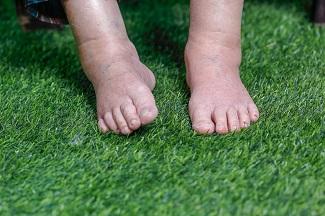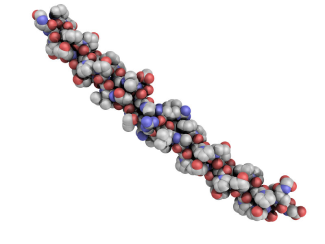Edema: Common Risk Factors and Complications
November 21, 2019
Edema is the abnormal accumulation of excess fluid within tissue. The swelling associated with edema can be localized to a small area following an acute injury, it can affect an entire limb or a specific organ, or it can be generalized throughout the entire body. Edema is not a disease, but rather a symptom that can indicate general health status, side effects of medications, or serious underlying medical conditions.1 Normally, fluid is exchanged in the body through intravascular (the vascular system and chambers of the heart) or extravascular (all other interstitial areas) compartments. This fluid movement is governed by a balance of hydrostatic and oncotic pressures. When the balance of these pressures is disrupted and the filtration capacity of the lymphatic system is overwhelmed, the result is edema.1
Compression Garment Selection for Kidney Failure-Related Edema
Symptoms of Edema
Swelling is the most prevalent symptom of edema, with variations in location and type indicating different underlying issues. Peripheral edema affects the extremities and can be exacerbated by prolonged sitting or standing. Peripheral edema manifests differently by order of severity. In severe cases with pitting edema, finger pressure applied to the site of swelling will leave a depression lasting from 10 to 30 seconds. In non-pitting edema, finger pressure will not result in a lasting depression. Anasarca is general edema affecting the entire body. Abdominal edema is referred to as ascites and is an indication of peritoneal cavity fluid retention. The skin of areas affected with edema may appear shiny and taut with swelling.2
Common Risk Factors Associated With Edema
General health factors contributing to mild forms of edema include prolonged sitting or standing, skin injury, excessive sodium consumption, premenstrual hormonal changes, and pregnancy. None of these factors are indicative of significant health issues, and the edema in each of these cases is usually temporary.3 Edema can also be a side effect of several common medications. These include blood pressure medications, certain diabetes medications, estrogens, non-steroidal anti-inflammatory drugs (NSAIDs), corticosteroids, and vasodilators. Most of these reactions are non-critical, but allergic reactions to medications can cause tongue or throat edema requiring emergency medical treatment.2 The most serious risk factors associated with edema are systemic diseases involving the heart, kidneys, liver, and lungs. 3
- Chronic lung diseases such as chronic bronchitis or emphysema resulting in pulmonary edema may contribute to shortness of breath and low blood oxygen levels.
- Chronic venous insufficiency caused by varicose veins and thrombophlebitis manifests in fluids accumulating in the feet and ankles.
- Cirrhosis of the liver can cause increased pressure in abdominal blood vessels manifesting as an abdominal bulge from excessive fluid collected in the abdominal cavity, or ascites.
- Congestive heart failure may result in pulmonary edema when the heart is unable to pump blood efficiently. Increased pressure in the veins that circulate blood through the lungs eventually pushes fluid into the alveoli, thereby reducing lung capacity.
- Kidney disease may result in periorbital edema (swelling around eyes) or swelling of legs secondary to fluid accumulation caused by declining levels of protein (albumin) in the blood.
- Lymphedema, a disease resulting from lymphatic system dysfunction, can cause swelling in the legs or arms. This edema is from tissue fibrosis produced by proteinaceous fluid buildup as a result of this dysfunction. It has various causes and can be treated and managed, but not cured.
Potential Complications of Unmanaged Edema
Although mild cases of edema may resolve on their own, unmanaged edema stemming from chronic, systemic causes can result in a range of complications. Edema left untreated can cause skin stretching to a point of pruritus and discomfort accompanied by painful swelling, stiffness, and difficulty walking. Swollen areas are at increased risk of skin ulcers and infection. Blood clots in deep veins, a condition known as deep vein thrombosis, are more likely when blood circulation is decreased as a result of edema.2
Common Edema Treatments and Interventions
Patients with edema or who are at risk of developing edema can reduce their risk or symptoms by taking the following precautions:4
- Reducing daily consumption of sodium
- Participating in regular exercise
- Avoiding exposure to extreme temperatures (hot baths, saunas, etc)
- Wearing compression stockings, sleeves, or gloves
- Using compression clothing during air travel
- Receiving specialized lymphatic decongestive therapy
- Protecting the affected area from injury and moisturizing the skin often
- Elevating the affected area above heart level throughout the day
Diagnosis and treatment of the underlying condition causing severe edema are necessary to implement a long-term plan for management. Severe or chronic edema may require treatment with diuretic medications to help increase the volume of fluid excreted by the kidneys. References
1. Trayes KP, Studdiford JS, Pickle S, Tully A. Edema: diagnosis and management. Am Fam Physician. 2013;88(2):102–110. https://www.aafp.org/afp/2013/0715/p102.html. Accessed October 11, 2019
2. Mayo Foundation for Medical Education and Research. Edema. http://www.mayoclinic.com/health/edema/DS01035. Mayo Clinic; 2011. Accessed October 11, 2019.
3. Phelps KR. Edema. In: Walker HK, Hall WD, Hurst JW, eds. Clinical Methods: The History, Physical, and Laboratory Examinations. 3rd ed. Boston: Butterworths; 1990.
4. Bobkova I, Chebotareva N, Kozlovskaya L, Shilov E. Edema in renal diseases – current view on pathogenesis. Nephrology @ Point of Care. 2016;2(1):e47–e55. https://doi.org/10.5301/pocj.5000204. Accessed November 3, 2019.
The views and opinions expressed in this blog are solely those of the author, and do not represent the views of WoundSource, HMP Global, its affiliates, or subsidiary companies.













Follow WoundSource
Tweets by WoundSource